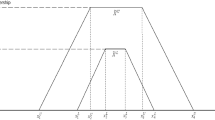Abstract
Quality function deployment (QFD) has been developed by Toyota Motor Corporation in order to reduce time and shorten design times. QFD is composed of a set of matrices referred to as the house of quality (HOQ). A HOQ matrix can help the cross-functional team to translate customer requirements (CRs) into engineering goals. The importance of CRs and the relationships between CRs and technical characteristics (TCs) are obtained by a group of people with vague and fuzzy decision-making processes in the HOQ. In the conditions, a group decision-making method by using the combination of fuzzy set theory and genetic algorithms (GAs) can be used in QFD to determine the importance of each TC. Besides, a numerical example is illustrated to show that this group decision-making method by using the combination of fuzzy set theory and GAs can be reliably and precisely applied in QFD including TCs at the two-level hierarchy with the consideration of some constraints regarding budget and time limits of TCs for prioritizing TCs to effectively make decisions with fuzziness and ambiguousness.
Similar content being viewed by others
References
Bai H., Kwong C.K.: Inexact genetic algorithm approach to target values setting of engineering requirements in QFD. Int. J. Prod. Res. 41(16), 3861–3881 (2003)
Bottani E., Rizzi A.: Strategic management of logistic service: a fuzzy QFD approach. Int. J. Prod. Econ. 103, 585–599 (2006)
Chan L.K., Wu M.L.: Quality function deployment: a comprehensive review of its concepts and methods. Qual. Eng. 15(1), 23–35 (2002–2003)
Chan L.K., Wu M.L.: A systematic approach to quality function deployment with a full illustrative example. Omega 33, 119–139 (2005)
Chan L.K., Kao H.P., Ng A., Wu M.L.: Rating the importance of customer needs in quality function deployment by fuzzy and entropy methods. Int. J. Prod. Res. 37(11), 2499–2518 (1999)
Chase R.B., Jacobs F.R., Aquilano N.J.: Operation Management for Competitive Advantage with Global Cases, 11th edn. McGraw-Hill, New York (2006)
Chau K.W.: A review on the integration of artificial intelligence into coastal modeling. J. Environ. Manag. 80, 47–57 (2006)
Cheng T.M., Feng C.W., Hsu M.Y.: An integrated modeling mechanism for optimizing the simulation model of the construction operation. Autom. Constr. 15, 327–340 (2006)
Dzeng R.J., Lee H.Y.: Optimizing the development schedule of resort projects by integrating simulation and genetic algorithm. Int. J. Proj. Manag. 25, 506–516 (2007)
Finch B.J.: OperationsNow.com: Processes, Value, and Profitability, International Edition. McGraw-Hill, New York (2003)
Fitzsimmons J.A., Fitzsimmons M.J.: Service Management (Operation, Strategy, and Information Technology), 5th edn. McGraw-Hill, New York (2006)
Gen M., Cheng R.: Genetic Algorithms and Engineering Optimization. Wiley, New York (2000)
Goldberg D.E.: Genetic Algorithms in Search, Optimization, and Machine Learning. Addison-Wesley, Reading, MA (1989)
Gryna F.M.: Quality Planning and Analysis: From Product Development Through Use. McGraw-Hill International Edition, New York (2001)
Han C.H., Kim J.K., Choi S.H.: Prioritizing engineering characteristics in quality function deployment with incomplete information: a linear partial ordering approach. Int. J. Prod. Econ. 91, 235–249 (2004)
Hauser J.R., Clausing D.: The house of quality. Harv. Bus. Rev. 66(3), 63–73 (1988)
Holland J.: Adaptation in Natural and Artificial System. University of Michigan Press, Ann Arbor, MI (1975)
Huang G.Q., Zhang X.Y., Liang L.: Towards integrated optimal configuration of platform products, manufacturing processes, and supply chains. J. Oper. Manag. 23, 267–290 (2005)
Kalargeros N., Gao J.X.: QFD: focusing on its simplification and easy computerization using fuzzy logic principles. Int. J. Veh. Des. 19(3), 315–325 (1998)
Karsak E.E.: Fuzzy multiple objective programming framework to prioritize design requirements in quality function deployment. Comput. Ind. Eng. 47, 149–163 (2004)
Khoo L.P., Ho N.C.: Framework of a fuzzy quality function deployment system. Int. J. Prod. Res. 34(2), 299–311 (1996)
Kim K., Moskowitz H., Dhingra A., Evans G.: Fuzzy multi-criteria models for quality function deployment. Eur. J. Oper. Res. 121, 504–518 (2000)
Kim D.H., Abraham A., Cho J.H.: A hybrid genetic algorithm and bacterial foraging approach for global optimization. Inform. Sci. 177, 3918–3937 (2007)
Ko H.J., Evans G.W.: A genetic algorithm-based heuristic for the dynamic integrated forward/reverse logistics network for 3PLs. Comput. Oper. Res. 34, 346–366 (2007)
Krajewski L.J., Ritzman L.P., Malhotra M.K.: Operation Management: Processes and Value Chains, 8th edn. Pearson Education. Inc., Upper Saddle River, NJ (2007)
Leu S.S., Chen A.T., Yang C.H.: A GA-based fuzzy optimal model for construction time-cost trade-off. Int. J. Proj. Manag. 19, 47–58 (2001)
Li R.J.: Fuzzy method in group decision making. Comput. Math. Appl. 38, 91–101 (1999)
Liu C.H., Wu H.H.: A Fuzzy group decision-making method in the relationship between customer requirements and technical measures of quality function deployment. Int. J. Ind. Eng. 15(2), 211–219 (2008)
Masud, A.S.M., Dean, E.B.: Using fuzzy sets in quality function deployment. In: Proceedings of the 2nd Industrial Engineering Research Conference, Los Angeles, CA, 26–27 May 1993
Nakamura K.: Preference relations on a set of fuzzy utilities as a basis for decision making. Fuzzy Sets Syst. 20, 147–162 (1986)
Pendharkar P.C., Koehler G.J.: A general steady state distribution based stopping criteria for finite length genetic algorithms. Eur. J. Oper. Res. 176, 1436–1451 (2007)
Stevenson W.J.: Operations Management, 9th edn. McGraw-Hill Companies Inc., New York (2007)
Tan K.C., Shen X.X.: Integrating Kano’s model in the planning matrix of quality function deployment. Total Qual. Manag. 11(8), 1141–1151 (2000)
Toroslu I.H., Arslanoglu Y.: Genetic algorithm for the personnel assignment problem with multiple objectives. Inform. Sci. 177, 787–803 (2007)
Vanegas L.V., Labib A.W.: A fuzzy quality function deployment (FQFD) model for deriving optimum targets. Int. J. Prod. Res. 39(1), 99–120 (2001)
Yuan Y.: Criteria for evaluating fuzzy ranking methods. Fuzzy Sets Syst. 44, 139–157 (1991)
Xu J., Liu Q., Wang R.: A class of multi-objective supply chain networks optimal model under random fuzzy environment and its application to the industry of Chinese liquor. Inform. Sci. 178(8), 2022–2043 (2008)
Author information
Authors and Affiliations
Corresponding author
Rights and permissions
About this article
Cite this article
Liu, CH. A group decision-making method with fuzzy set theory and genetic algorithms in quality function deployment. Qual Quant 44, 1175–1189 (2010). https://doi.org/10.1007/s11135-009-9304-1
Published:
Issue Date:
DOI: https://doi.org/10.1007/s11135-009-9304-1




